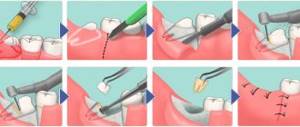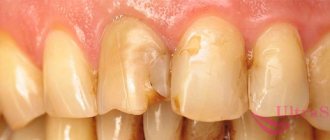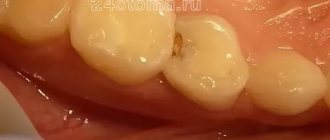Translated from Latin, “separatio” means “separation,” and in dentistry this name was given to the procedure of grinding off a thin layer of enamel from the lateral surfaces of adjacent teeth. Separation, that is, separation of teeth, is used by professionals exclusively for indications and belongs to the category of effective and at the same time gentle, humane dental procedures. However, many patients are frightened by the process of removing a thin layer of tooth enamel, and they resolutely refuse this manipulation. Let's figure out why there is a need to grind teeth, and how does partial removal of enamel affect their health?
Indications
There are opposing opinions among dentists regarding the procedure, but there are situations in which filing is necessary:
- When installing crowns. For reliable fixation of the crown, it must fit tightly to the tooth surface.
Since the anatomical shape of each molar or incisor is not ideal, grinding down of the upper layers of their hard tissue is required. This allows you to give your own bone organ the correct geometric shape, thanks to which the manufactured product is firmly fixed and does not stand out among other elements of the jaw row. - For fixing veneers. Ceramic plates fixed to the surface of your own teeth have a certain thickness.
Therefore, in order for the installed microprostheses to fit firmly and not protrude beyond the boundaries of the native units, a small amount of hard tissue is ground off from the vestibular side of the elements of the jaw row. - Preparation for inlays. If it is necessary to mask the cavity formed as a result of carious lesions, ceramic or metal inlays can be used.
Their fixation requires the creation of side walls and the formation of the required depth near the cavity. - In case of installation of an orthodontic structure. Cutting down a small thickness of the top layer of the tooth allows you to make room for correcting the position of the remaining elements of the row without the need to remove them.
In addition, this option is often used in cases of increased crowding of teeth, since it facilitates the placement of fastening elements of the bracket system on them. - If there is damage to the enamel. Chips on the surface of the front incisors can be made less noticeable by slightly filing down the enamel.
This improves the aesthetics of the appearance of the jaw row and eliminates the need for composite restoration. - In case of elongated incisors. If the front teeth are longer than the rest of the row, this can not only cause psychological discomfort, but also interfere with correct diction or complete chewing of food.
To solve the problem, in some cases, filing the length of organs protruding from the common line is used. - At sharp angles. The anatomical structure of the anterior incisors is not always ideal. If there are sharp corners, dentists may recommend filing them down, which will increase the aesthetic appearance of the entire jaw row.
Indications for the use of orthoimplants and tactics for their installation.
Let's discuss here how the braces system works.
At this address https://orto-info.ru/ortodonticheskoe-lechenie/podgotovitelnyiy-period/separatsiya-zubov.html we will talk about abrasive teeth separation.
Dental restoration options
The clinic can provide all types of dental restoration services.:
- Artistic restoration using advanced filling materials.
- Restoration of a pulpless (dead) tooth, if the root canals are treated correctly. Pins and crowns are used.
- Microprosthetics: veneers, onlays, inlays.
- Restoration of the coronal part after implantation: fixation of the crown to the implant.
Contraindications
The necessity and admissibility of filing teeth is determined by the dentist individually in each case, since the procedure is quite labor-intensive and can be traumatic in some situations.
For this reason, sewing hard fabric is contraindicated in the following situations:
- increased abrasion of enamel;
- hyperesthesia;
- bruxism;
- presence of bad habits - frequent chewing of seeds and nuts, opening bottles with teeth;
- high risk of injury to the incisors, for example, boxing and other types of wrestling.
Planning the result
At this stage, the orthodontist realistically evaluates all the diagnostic results obtained and calculates the order of the upcoming installation of braces. A decision is made about whether teeth need to be installed before braces. All stages and the order of their implementation are discussed with the patient.
The time of wearing the corrective structure depends, first of all, on the complexity of the deformation of the dentition.
This process is always purely individual. The average duration of treatment is from 12 to 24 months.
If necessary, the patient receives a referral to other specialized specialists for complete comprehensive sanitation of the oral cavity. At Narodnaya Dentistry, all specialists work harmoniously and purposefully. Having our own modern equipment allows us to make a diagnosis in the shortest possible time and begin treatment immediately.
Technique
The procedure for filing teeth is carried out in several stages:
- Preparation. At the first meeting, the dentist assesses the condition of the patient’s jawbone elements, determines whether there is a need for cutting down hard tissue and whether there are contraindications to the procedure.
- Identifying problem areas. Using carbon paper, a liquid aerosol or a wax plate, the dentist determines the overestimated areas of the tooth. Areas that require sanding will be colored more intensely.
- Sawing. The filing procedure may vary slightly depending on the goal to be achieved and the shape of the tooth being processed.
So, when treating chewing molars, the dentist carefully grinds off the top layer of enamel from the surface of the tubercles. When cutting down the front incisors, multidirectional movements are carried out.
In some cases, it may be necessary to preliminary make a diagnostic model based on casts of the patient’s jaw rows.
The resulting gypsum sample is subjected to careful inspection and evaluation filing. Carborundum cutters or diamond burs are used as instruments for the operation
The procedure often ends with polishing and remineralization of the treated units. The dentist applies a certain composition containing a complex of useful substances to the enamel to increase the strength of the outer layer of the tooth and reduce permeability .
How is aesthetic restoration performed?
Indirect
- The orthopedist grinds down the necessary teeth, takes impressions of the jaws, and sends them to the dental laboratory.
- Temporary crowns are fixed onto the ground structures.
- In the laboratory, a dental technician makes orthopedic structures: crowns, veneers, onlays.
- When the permanent structures are made, the doctor fixes them with heavy-duty material.
This type of restoration is considered to be as aesthetic as possible, as it is made using individual impressions for each individual patient. The fixed orthopedic structure will be ideal in color, shape, and anatomy.
Direct restoration (composite)
- The doctor determines the color of the future restoration.
- Provides pain relief.
- Installs an insulation system: cofferdam. This allows you to isolate the enamel from moisture and plaque.
- Tooth preparation: surface preparation, canal treatment (if necessary).
- The doctor restores the tooth with filling materials and applies them layer by layer. The material hardens under the influence of radiation from a special lamp.
- The final stage involves grinding and polishing.
It is worth noting that it is recommended to cover dead teeth (depulped) with orthopedic crowns, and not just composite restorations, since a tooth without a nerve is fragile.
After such treatment, regular monitoring of the tooth is required: polishing should be done every six months. This will allow you to maintain the unchanged appearance of the filling for a long time.
Contraindications
- lack of chewing teeth;
- bruxism;
- incorrect bite: then correction of the jaw bite is required.
Increased sensitivity after the procedure
Many patients who have had their teeth filed complain of increased sensitivity, especially when eating hot and cold dishes and hard foods.
Dentists explain this phenomenon as follows. Dentin, located under the enamel, is penetrated by many tubules, inside of which nerve endings are located. As the thickness of the enamel decreases, pressure changes occur, which can cause pain when taking certain foods.
To reduce tooth sensitivity after the procedure, dentists recommend temporarily avoiding too hard foods, dishes with high and low temperatures, and acidic drinks.
During oral hygiene, you should use a brush with soft bristles and therapeutic and prophylactic toothpaste, rinses for sensitive teeth.
If sensitivity does not disappear a week after filing, you should contact your dentist.
Indications and contraindications for orthognathic surgery, recovery time.
In this article we will tell you how to install braces on crowns.
Follow the link https://orto-info.ru/ortodonticheskoe-lechenie/podgotovitelnyiy-period/informativnost-telerentgenogrammyi.html if you are interested in the importance of a teleroentgenogram in orthodontics.
Types of dental restorations
Today there are two varieties:
- Direct restoration: filling materials are used, which are applied layer by layer and harden under the influence of a special lamp. The material is carefully selected in color so that it completely matches its neighbors.
- Indirect : such restoration includes the stage of manufacturing orthopedic structures in a dental laboratory: veneers, crowns, onlays. They are made individually for each patient using impressions.
At home
Fear of doctors and thoughts about the pain of professional manipulations often lead to patients trying to cope with the existing problem on their own. Teeth filing is also no exception.
Dentists share their experience that people often come to appointments whose enamel has been severely damaged by attempts to cut off part of it with various improvised tools in the desire to improve the aesthetic appearance of the jaw row with prominent front teeth or the presence of chips.
In addition to the problem of high sensitivity, these patients experience cracks in the hard tissue, as well as dentin damage, which develops as a result of bacteria entering the dentinal tubules through open pores.
The consequence of such independent actions can be the development of caries, pulpitis and numerous complications that can lead to partial or complete tooth destruction.
Dentists categorically prohibit performing teeth filing procedures at home. Only a specialist can determine the need for an operation to remove a section of enamel and carry it out efficiently, without the risk of complications.
When is dental restoration required?
Indications:
- Presence of caries.
- Aesthetic defects of the dentition: chips, cracks, darkening.
- Old fillings that are noticeable and stand out when you smile.
- Presence of large interdental spaces.
- Non-carious lesions: fluorosis, enamel hypoplasia, enamel necrosis and others.
- Minor crooked teeth that can be corrected without installing braces.
Price
The cost of filing teeth depends on the reasons for which it is carried out and what result is needed to achieve:
- preparation for caries - from 200 to 350 rubles per row element;
- treatment of enamel after removing braces – 550-650 rubles;
- identification of traumatic occlusion and grinding of one tooth – 200-300 rubles;
- cutting down a tooth for a crown – 130-200 rubles;
- filing a molar under an orthodontic structure – 150-200 rubles.
Find out how teeth are prepared in the video.
Who is indicated and contraindicated
Teeth grinding is a dental procedure that is aimed at correcting visible defects: uneven edges, enamel damage, and malocclusion.
In addition, it is used during operations, using it as a preparatory stage. The procedure is performed under anesthesia and is therefore not painful.
Photos before and after teeth filing:
Before going for dental filing, consultation with a specialist is required. Whether it is possible to file the front teeth depends on the presence of contraindications, which include:
- bruxism (teeth grinding during sleep, occurs regularly at night);
- increased sensitivity of enamel;
- accelerated destruction of tooth enamel;
- the patient's exposure to bad habits (gnawing nuts with his mouth, nibbling the ends of pens and pencils);
- increased risk of injury to incisors or canines (especially in boxers and wrestlers).
If the specialist did everything correctly, the teeth will be filed without difficulty. There can be only one nuance - the enhanced sensuality of the enamel. But it lasts for a few days and then goes away. The existing correction options are calculated by the doctor you contacted. Dental grinding is necessary when other correction options, in the opinion of a specialist, will not help.
How long to wear braces
Straightening teeth is a very painstaking process. Regardless of the type and material of the leveling structure, it will have to be worn for 1-1.5 years. In some cases, the duration of treatment is 2 years. If we take into account the need for subsequent use of retainers and mouth guards, the time period will increase even more.
No need to be upset. The jaws quickly get used to the metal arches, and therefore after just a few weeks of using them, a person practically stops noticing them. It is much wiser to spend one or two years on orthodontic therapy than to suffer for the rest of your life due to an incorrect bite.










